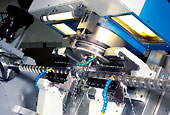Autonetics continues its expansion of modern industrial optical metrology products to include in-process, PCP (Progressive Cavity Pump) rotor inspection. The tight tolerances and long cycle times encountered in rotor production necessitates inspection during the whirling process to avoid costly waste of materials and machining time.
PCP rotors are used in a variety of applications including the petroleum industry, foodstuff manufacture, chemical production and waste water management to name a few. Although this technology spans decades sustained improvements continue to broaden its usage. A progressive cavity pump moves most any fluid, even one that includes delicate or abrasive particulate, without damage to the inclusions or the pump.
The progressive cavity pump was developed and patented by Dr. Rene Moineau in France more than 70-yr ago. The interaction of a single-threaded, helical rotor rolling eccentrically within a solid, helical stator, internally double-threaded with double the rotor pitch length, produces a series of cavities, 180-deg apart, progressing from inlet to outlet. The cavities follow each other and produce a pulsation free, positive displacement flow without the need for valves. This basic configuration is called a 1:2 profile.
Progressive cavity pumps with other profiles, from 2:3 up to 9:10 are possible. The 2:3 profile can either increase flow by 150% at the same speed or reduce speed and wear while still maintaining the original flow. A second patent used an elastomeric stator to achieve a compression fit with the rotor, eliminating any clearance requirements. The effect was high volumetric efficiencies with fluids of high and low viscosities, as well as abrasion resistance superior to all other positive displacement pumps.The displacement of a progressive cavity pump depends on three design features: (Rotor diameter, Rotor eccentricity, Stator pitch). The pump’s pressure rating depends on the number of stages. By repeating the identical, single-helical configuration, increasing the length of the stator and rotor increases the number of stages. Flow through the elements is not far removed from the straightest distance between suction and discharge. The result is relatively low velocity and shear for a given displacement and excellent capabilities for handling highly viscous and sensitive slurries. A good example is the ability to pump oil and water mixtures without emulsification.
The complex geometry along with the intense amount of wear and pressure put on these rotors requires unsurpassed measurement skill and quality steels to ensure a proper fit with the stator. To these ends, Autonetics has develloped a product that can be mounted to the cutting head which obtains major and minor diameters, once per rotor revolution, with 1µm accuracy. Typically the requirements are 25µm to 50µm with allowance for thermal growth. Our array includes 3 solid state thru-beam light curtains with extremely fast, real time, measurement to provide precision when gaging moving targets. Information is conveyed from the sensors to the machine control for tool compensation and product traceability insuring quality control and reducing costly waste.


